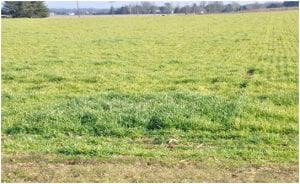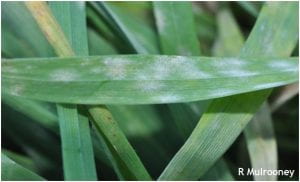Bob Mulrooney, Extension Plant Pathologist; bobmul@udel.edu
Powdery Mildew on Small Grain
Be on the lookout for powdery mildew on ‘Thoroughbred’ barley and wheat. Powdery mildew has been seen on both within the last several weeks. ‘Thoroughbred’ barley is very susceptible to PM as you know and if the stand is thick and lush you will more than likely see it. Does it need to be controlled this early in the season? I think it depends on how many times you are willing to spray it. Dr. Arv Grybauskas did a trial last season looking at fungicide applications at jointing (GS6), flag leaf emergence (GS9) and flowering (GS10.5) Tilt (4.0 oz/A) was applied at GS 6 or 9 and Prosaro (6.5 fl. oz/A) was applied at GS 10.5. While all treatments gave a positive yield response in two trials, only the later applications gave a significant yield increase. It confirms what we have been saying about the importance of keeping the top two leaves free of disease and the positive relation to grain fill. This is true in wheat and susceptible barley like ‘Thoroughbred’. If you spray to control mildew at jointing you may have to come back again later because the control will not last season-long. Disease control later is more important for protecting the yield potential of the crop.
For powdery mildew on wheat, check areas of rank growth first to see if the disease is present in the field then revisit to see if it spreads. It is too early to consider control of powdery mildew (PM), but if it is present, keep scouting. Unless the variety is very susceptible the mildew does not move fast depending on the weather.
Rank areas, like the one pictured here that was infected with powdery mildew, should be checked often.
Close-up of powdery mildew as it looks now
Rust on Small Grain
Everyone has been wondering about the possible consequences of the warm winter and one consequence might affect wheat. Both leaf rust and stripe rust have been found in the South this winter. It has been mild and relatively moist depending on the location. This scenario is conducive for rust infections that get started in the southern production regions and blow north as the season progresses. With the early appearance down south, the mid-Atlantic area may see rusts early enough to be a threat. Keep your eyes open as the season progresses.




